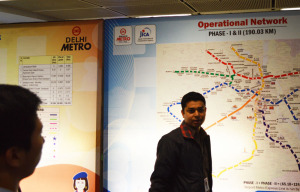This morning we heard from the Executive Director of the most successful Metro Rail Corporation. The Delhi metro impressed everyone with its cleanliness, coverage, frequency of trains, and its overall sustainable business model. For a metro system that is only 13 years of age, it was extremely impressive to see how Delhi’s metro initiatives came to fruition in such a short amount of time. When I asked the director why he thinks they were able to build the system so rapidly, he was quick to point out that India is a democracy and that citizens may challenge the metro at any point. However, the supreme court often sides with the metro because it is a public good providing utility for a great amount of citizens (about 2.5 million per day to be exact). Therefore, he believes that the public-private partnership is the reason for the metro’s success. If the government had not passed down decision making power to the private corporation formed to build and maintain the metro, phase one would have probably finished this year rather than in 2002. I believe that the U.S. can benefit greatly from the public-private partnership and will make sure to consider its benefits as my group develops a smart city plan for Oakland.
 Probably the most surprising thing we learned about the metro system is that it is profitable. This is because it is a private corporation rather than a government-funded bureau (that receives a grant regardless of performance as in the U.S.), the main goal is to make a profit. Even with 60% of its revenue going to cleaning and maintenance of the system, the company is still able to use the remaining 40% to pay back its 1.5% interest rate loan from the Japanese government. In addition, to increase its revenue, the company has a diverse portfolio of investments in land and recreation that allow it to make an operating profit rather than just break even. By learning from successful metro systems in cities like Hong Kong and Tokyo, and taking lessons from the unprofitable systems elsewhere, the Delhi metro’s business model of private-public partnership, an investment portfolio, partnerships with other countries will serve as a great resource for our smart city plans.
Probably the most surprising thing we learned about the metro system is that it is profitable. This is because it is a private corporation rather than a government-funded bureau (that receives a grant regardless of performance as in the U.S.), the main goal is to make a profit. Even with 60% of its revenue going to cleaning and maintenance of the system, the company is still able to use the remaining 40% to pay back its 1.5% interest rate loan from the Japanese government. In addition, to increase its revenue, the company has a diverse portfolio of investments in land and recreation that allow it to make an operating profit rather than just break even. By learning from successful metro systems in cities like Hong Kong and Tokyo, and taking lessons from the unprofitable systems elsewhere, the Delhi metro’s business model of private-public partnership, an investment portfolio, partnerships with other countries will serve as a great resource for our smart city plans.
This afternoon we engaged with the Senior Executives of India’s Department of Telecommunications, the sole government agency, that policy making body for Telecommunications in the country. The senior executives of India’s Department of Telecommunications were extremely helpful in allowing us to understand how telecommunications plays an essential role in building smart cities. In essence, what they are doing is bringing digital connectivity to everybody through broadband. Their goal is to do this by creating ecosystems in which there can and will be access to information for people and businesses across all social levels. Some of their key challenges in building smart cities is finding the finances to pay for all of the fiber optic cables into villages, new cities, and old cities. Additionally, the government does not capture data because it is private property, which means that although there could be much data utilized for the building of smart cities, it won’t matter because of privacy. This department is vital in smart cities growth in India because it will establish the policies that are needed to set the parameters of this growing industry. For example, with the growth of smart cities in India, there will be an increasingly large amount of telecommunication companies. With these, the government must regulate this industry so that there are no monopolies started by these companies and so that the citizens of India can receive telecommunications services for free. Overall the dialogue and innovative solutions made were highly applauded with all its complexity.
By Isabelle Lee and Roman Decca

